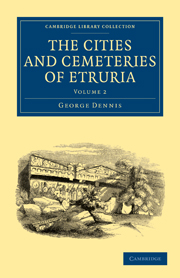Book contents
- Frontmatter
- Contents
- List Of Illustrations In Volume II
- CHAPTER XXX CIVITA VECCHIA—CENTUM CELLÆ.
- CHAPTER XXXI SANTA MARINELLA—PUNICUM
- CHAPTER XXXII SANTA SEVERA.—PYRGI
- CHAPTER XXXIII CERVETRI—AGYLLA OR CÆRE.
- CHAPTER XXXIV PALO—ALSIUM
- CHAPTER XXXV LUNI—LUNA
- CHAPTER XXXVI PISA.—PISÆ.
- CHAPTER XXXVII FIRENZE.—FLORENTIA
- CHAPTER XXXVIII FIESOLE.—FÆSULÆ
- CHAPTER XXXIX SIENA—SENA.
- CHAPTER XL VOLTERRA.—VOLATERRÆ
- CHAPTER XLI VOLTERRA.—VOLATERRÆ
- CHAPTER XLII THE MAREMMA
- CHAPTER XLIII POPULONIA—POPULONIA
- CHAPTER XLIV ROSELLE—RUSELLÆ
- CHAPTER XLV TELAMONE—TELAMON
- CHAPTER XLVI ORBETELLO
- CHAPTER XLVII ANSEDONIA—COSA
- CHAPTER XLVIII VETULONIA
- CHAPTER XLIX SATURNIA—SATURNIA
- CHAPTER L CHIUSI—CLUSIUM
- CHAPTER LI CHIUSI—CLUSIUM
- CHAPTER LII CHIUSI—CLUSIUM
- CHAPTER LIII CETONA AND SARTEANO
- CHAPTER LIV CHIANCIANO AND MONTEPULCIANO
- CHAPTER LV AREZZO—ARRETIUM
- CHAPTER LVI CORTONA—CORTONA
- CHAPTER LVII PERUGIA—PERUSIA
- CHAPTER LVIII PERUGIA—PERUSIA
- CHAPTER LIX ROME
- Index
- ERRATA IN VOL. II.
- Maps
CHAPTER LII - CHIUSI—CLUSIUM
Poggio Gajella
Published online by Cambridge University Press: 05 July 2011
- Frontmatter
- Contents
- List Of Illustrations In Volume II
- CHAPTER XXX CIVITA VECCHIA—CENTUM CELLÆ.
- CHAPTER XXXI SANTA MARINELLA—PUNICUM
- CHAPTER XXXII SANTA SEVERA.—PYRGI
- CHAPTER XXXIII CERVETRI—AGYLLA OR CÆRE.
- CHAPTER XXXIV PALO—ALSIUM
- CHAPTER XXXV LUNI—LUNA
- CHAPTER XXXVI PISA.—PISÆ.
- CHAPTER XXXVII FIRENZE.—FLORENTIA
- CHAPTER XXXVIII FIESOLE.—FÆSULÆ
- CHAPTER XXXIX SIENA—SENA.
- CHAPTER XL VOLTERRA.—VOLATERRÆ
- CHAPTER XLI VOLTERRA.—VOLATERRÆ
- CHAPTER XLII THE MAREMMA
- CHAPTER XLIII POPULONIA—POPULONIA
- CHAPTER XLIV ROSELLE—RUSELLÆ
- CHAPTER XLV TELAMONE—TELAMON
- CHAPTER XLVI ORBETELLO
- CHAPTER XLVII ANSEDONIA—COSA
- CHAPTER XLVIII VETULONIA
- CHAPTER XLIX SATURNIA—SATURNIA
- CHAPTER L CHIUSI—CLUSIUM
- CHAPTER LI CHIUSI—CLUSIUM
- CHAPTER LII CHIUSI—CLUSIUM
- CHAPTER LIII CETONA AND SARTEANO
- CHAPTER LIV CHIANCIANO AND MONTEPULCIANO
- CHAPTER LV AREZZO—ARRETIUM
- CHAPTER LVI CORTONA—CORTONA
- CHAPTER LVII PERUGIA—PERUSIA
- CHAPTER LVIII PERUGIA—PERUSIA
- CHAPTER LIX ROME
- Index
- ERRATA IN VOL. II.
- Maps
Summary
Crede milii, vires aliquas natura sepulcris
Attribuit; tumulos vindicat umbra suoa.
Seneca.Ut quondam Cretâ fertur Labyrinthus in altâ
Parietibus textum cæcis iter, ancipitemque
Mille viis habuisse dolum, quà signa sequendi
Falleret indeprensus et irremeabilis error.
Virgil.It is a notable fact that but one description of an Etruscan tomb is to be found in ancient writers; and that tomb was at Clusium—the mausoleum of Lars Porsena. It is thus described by Varro, as quoted by Pliny :—
“He was buried under the city of Clusium, in a spot where he has left a monument in rectangular masonry, each side whereof is three hundred feet wide, and fifty high, and within the square of the basement is an inextricable labyrinth, out of which no one who ventures in without a clue of thread, can ever find an exit. On that square basement stand five pyramids, four at the angles, and one in the centre, each being seventy-five feet wide at its base, and one hundred and fifty high, and all so terminating above, as to support a brazen circle and a petasus, from which are hung by chains certain bells, which, when stirred by the wind, resound afar off, as was formerly the case at Dodona. Upon this circle four other pyramids are based, each rising to the height of one hundred feet. And above these, from one floor, five more pyramids, the height whereof Varro was ashamed to mention. The Etruscan fables record that it was equal to that of the rest of the structure.”
- Type
- Chapter
- Information
- The Cities and Cemeteries of Etruria , pp. 385 - 400Publisher: Cambridge University PressPrint publication year: 2010First published in: 1848

